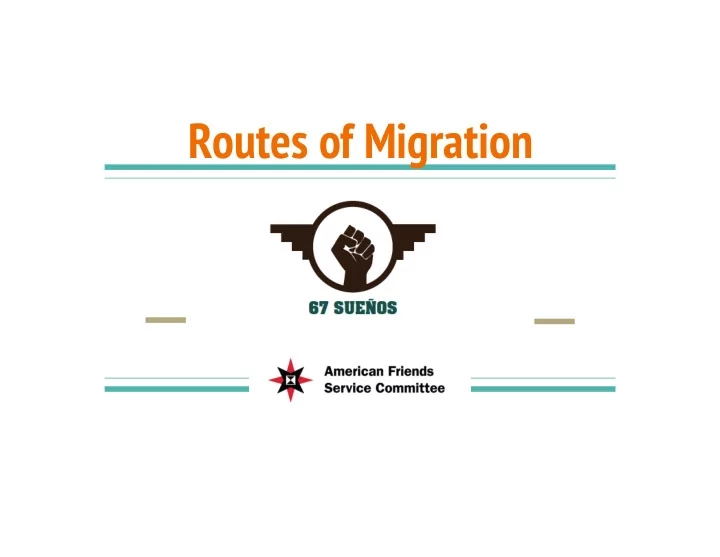

Routes of Migration
Routes of migration into the U.S. from Central America and below are becoming increasingly more life-threatening due to the hyper-militarization of the border caused by Plan Merida & Plan Frontera Sur
Plan Merida: How the U.S. Exports Arms & Military Training to Mexico Originally signed in 2006 as a three-year program (though it continues functioning today), Plan Merida is “military aid package” / “border security cooperation agreement”. What this means is that: ● The U.S. offers to Mexico military-grade artillery, surveillance equipment, combat tactical training, and intelligence and database sharing ● The U.S. is now able to anticipate and prepare for unauthorized migration as it initiates from the Central America. (This effectively extends the border patrol power of the U.S. down to Mexico’s southern border) Through this Plan, the U.S. has spent almost $3 billion on exporting arms and training to Mexico since 2007. Merida was supposed to be a response to Mexico’s “drug problem”. Source: Colectivo Todo Poder al Pueblo (2015)
With Plan Merida Forces Blocking the Usual Routes, Migrants Find Other, More Lethal Routes to Cross Since 2013, the Mexican government has completed the following with the help of the U.S.: ● Established 12 advanced U.S.-trained naval bases along Mexico’s southern border rivers ● Built three security centers that stretch more than 100 miles north of the Mexico-Guatemala and Mexico-Belize borders ● Initiate U.S.-monitored drones along the southern Mexican border In 2015, the U.S. and Mexican governments approved a $75 million Merida program to help Mexico develop an automated biometrics system to help agencies collect, store, and share information on criminals and migrants. To facilitate this information sharing, a $13 million telecommunications system was built along the U.S.-Mexican border Source: Congressional Research Service (2017)
Plan Frontera Sur (PFS): Mexico / U.S. Response to Central American Unaccompanied Minors ● On July 7, 2014, Mexico President Peña Nieto announced Programa Frontera Sur, a border security plan that aimed to increased security measures at at least 12 points of entry at Guatemala and Belize, as well as on other popular migration routes in Mexico, such as the railroads. ● I n A u g u s t 2 0 1 6 , M e x i c o ’ s Communications and Transport Ministry reclaimed ownership of the cross-country railroad line known as “La Bestia”
More Dangerous Routes, Deadly Outcomes With PSF shutting down La Bestia, the migrant route has been replaced with walking untraversed roads. Some migrants walk in the hills, and some on the coast, sometimes paying for brief trips in fishing boats. Through these new routes, migrants are prey for kidnapping, rape, and extortion by organized crime and by corrupt police.
PSF Impact on the Youth
Roxana Hernandez & the 2018 Central American Caravan 33 y/o, Honduran Trans Person helping lead caravan of Central American asylees in Spring 2018 ● One of approximately 25 transgender and gender- nonconforming asylum seekers ● Detained in the transgender unit in the Cibola County Correctional Center, a CoreCivic-owned private prison that has contracts with ICE in New Mexico ● After becoming ill with HIV-related complications, she died from cardiac arrest ● Attempted crossing at least 3 times prior (2005, 2009, 2014) to flee LGBTQ+ persecution in Honduras How many of you would risk your body, uproot your life, and cross multiple borders every 5 years in hopes of finding freer living in a completely Source: CNN (2018) foreign country?
Central American Caravan Route: A month-long, 2000+ mile journey on bus & feet
Deadly Detention Conditions for Trans Folks Among the 30,000 migrants being held in detention across the U.S., there are approximately 65 trans women being held in detention on any given day Trans women are regularly subjected to: ● Humiliating and abusive strip searches by male guards ○ 15.2% of trans women in state and federal prisons reported abuse by facility staff ● Sexual assault and harassment by male inmates ○ 33.2% of trans women in state and federal prisons reported abuse by fellow inmates ● Blocked access to medical services, from basic treatment to hormone therapy ● Solitary confinement and “lockdowns” as a disciplinary action for breaking minor rules Case Study: Sara (Honduras): sexually assaulted at Arizona detention facility in 2014. Two men raped her in her cell while she awaited intake proceedings, while a third inmate stood look out. When Sara reported the rape to the staff, a guard shut her down: “ You [trans women] are the ones that cause these problems and always call the men’s attention .” Source: Human Rights Watch (2016)
Roxana’s Compañerxs and Paisanxs in the Caravan Photo Source: The Republic (2018)
The Migrant Detention Industrial Complex: Trump’s Zero Tolerance Policy & the DHS Budget ● Launched in April 2018, the Zero Tolerance Policy allows the detention and criminal prosecution of anyone who gets caught crossing without inspection, even for refugees & asylum-seekers ● Prior to passing this policy, DHS submitted a FY ‘19 budget requesting 2,500 beds to detain migrant families at three facilities, two of which are run by GEO Group, Inc. and CoreCivic, private prison companies. ● After passing the policy, DHS researched into costs for 15,000 beds, which added up to $5.6 million per day to jail families at a rate of $300 per bed per day. The annual costs for these 15k beds thus adds to more than $2 billion a year! ● This money is going into building separate youth and adult detention centers contracted by GEO Group, CoreCivic, and other private prison companies Source: Center for American Progress (2018)
Corporate Contributions to Trump Administration Source: Center for Responsive Politics (2018)
CoreCivic’s Facilities in the United States CoreCivic Facilities in the Southwestern Border Region Source: CoreCivic (2018)
Unaccompanied Central American Children
Recommend
More recommend